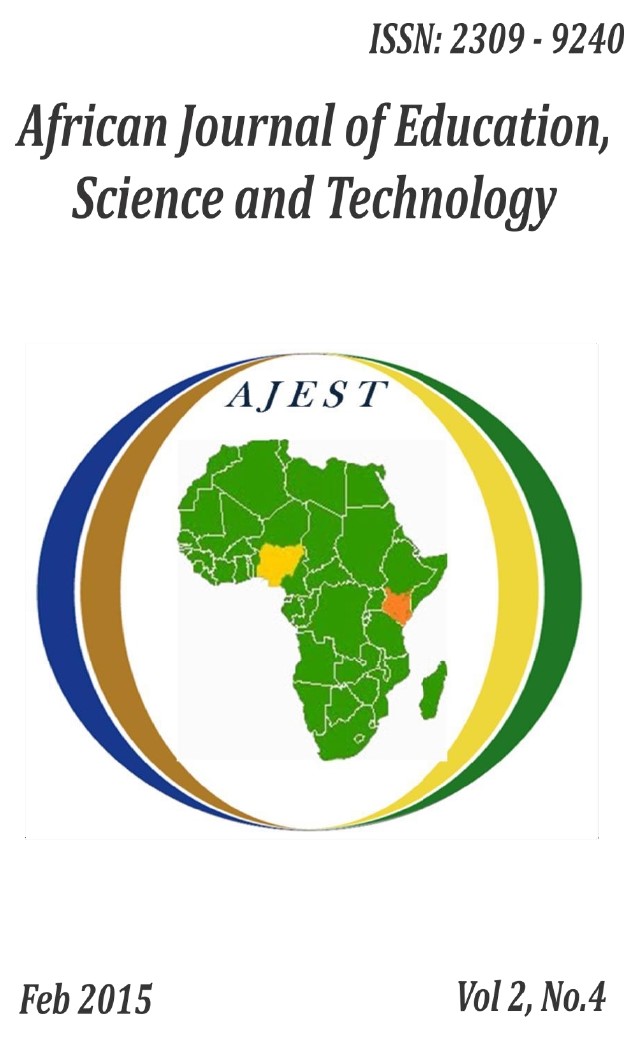Evaluation of Growth Performance of Kuchi Indigenous Chicken Ecotype Fed with Three Levels of Energy Diets in Three Different Systems of Management
##article.abstract##
A study was conducted to evaluate the growth performance of Kuchi indigenous chicken (IC) ecotype of Kenya. This ecotype has become popular for its high mature body weight. From week 12 to17, growth performance of the Kuchi growers was evaluated on the effects of three levels of energy diets: High (HE) 2700.5 MEKcal/Kg, Low (LE) 2564 MEKcal/kg and milled Maize Grain (MG); all managed under three systems of management: Extensive (ES),Extensive with Supplementation(ESS) and Intensive(IS). The HE and LE rations were specifically formulated for the experiments which were fed to the Kuchi growers on a two week change-over basis from week up to week 17.The experiment was laid under a Randomized Completely Block Design(RCBD);with three treatments(energy diet),three Blocks with two replicates(period in weeks)each with six experimental animals. Mean weekly weights were computed and analyzed by ANOVA using SAS (2011) software tool. Both Fisher‘s LSD and Duncan Student‘s Range were applied in separating means where differences were observed. Differences among management systems were not (p>0.05) statistically significant. Diet LE 2564MEKcal/kg had significant effect (p<0.05) on Kuchi growers; While diets HE and MG had no significance (p>0.05). It is concluded that Kuchi does not need an intensified management. Furthermore, a grower‘s supplementation ration of about 2564.5MEKcal/Kg is optimal under an extensive production system.
References
Ali, K.O, Katule, A.M., & Sirasaol, O. (2002). Genoytypic x Environmental interaction in growing chicken .A comparison of four genetic groups on two rearing systems under tropical conditions CTA Agri. Science 50, 65-71.
Chemjor (1998). Energy and protein requirements of indigents chickens of Kenya. (Msc) Thesis. Egerton University, Kenya. pp8
Chesoo, B.K., Kios, D.K., & Oduho, G.W. (2014). Evaluation of Three Management Systems on Growth performance of Kuchi Indigenous chicken Ecotype of Kenya. African Journal of
Science, Education and Technology (AJEST) 1(4) 170 – 174.
Chesoo, B.K., Kios, D.K., Kitilit, K., Rachuonyo, H.O., & Oduho, G.W. (2012). The Kuchi ecotype. An entry point towards improvement of Indigenous chicken production in Kenya. Unpublished MSC. Seminar paper; Dept of Animal Science; University Of Eldoret. Kenya.
Kareri, R. W. (1992). The sociological and economic values of Kenya‘s wetlands. In Wetlands of Kenya. Proceedings of the Kenya Wetland Working Group Seminar on wetlands of Kenya. National Museums of Kenya, Nairobi, Kenya (pp. 99-107).
Katule & Mgheni (1990). Performance of crosses between exotic and local Tanzanian chicken. The proceedings of the 4th World congress on Genetics Allied to livestock production pp62-64.
Kosgey, I. S. (2004). Breeding objectives and Breeding strategies for small ruminants in the tropics. PhD, Dissertation, Wagenningen Universtity, Wagenningen, The Netherlands. pp272.
Lwelamira, J., Kifaro, G.C., & Gwakisa, P.S. (2008). On- station and on-farm evaluation of two Tanzania chicken Ecotypes for body weight at different ages and egg production; African Journal of Agricultural Research, Dodoma Tanzania, 843-851.
Msoffe, P.L.M.(2003). Diversity among local chicken ecotypes in Tanzania. PhD Dissertation. Sokoine University of Agriculture. Morogoro, Tanzania. pp223
Mutua, E. (2010). Improving Nutrition through indigenous poultry. A case of Kuchi production in Lamu District, Mombasa. Kenya. Home Economics for Rwal Development.pp18.
Mwanza, R. (2010). Unveiling the Kuchi. Kenya Poultry Industry USAID On-Line.htm,file://F:Down loaded on 3/2/2011.Iringa, Tanzania 1-12.
Nielsen, H., Roos, N., & Tailstead, S.H (2003).The impact of semi scavenging poultry production on the consumption of animal sources food by women and girls in Bangladesh. Journal of
nutrition.1331 4027-4030.htt//in nutrients.org/cgi/reprint/133/11/40275.
Okitoi , L.O, .Kabwage, L.W Muiga.R.W., & Bandamana, M.S. (2010). Response of scavenging chicken to supplementation with varying nutrient densities. Kenya poultry.org/research /37-vari supplementing scavenging chicken.htmc. Accessed on 27/4/2014.
Pedersen, C.V. (2002). Productivity of semi scavenging chicken in Zimbabwe. PhD Thesis. The Royal veterinary and Agricultural Umienge(RVAU), Copenhagen Denmark pp133.
SAS (2011). Statistical Analysis Systems.SAS Enterprise guide. AS Institute Inc. NC.USA.
Segula–Correa, J. C., Samiendo-Franco, L., Magana-Montforte, J. G., & Santos-Ricalde, R. (2004). Productive Performance of Creole Chickens and their crosses raised under semi-intensive management conditions in Yucatan,Mexico. British Poultry Sc.45(3)342-345.
Smith, J. (1990). Poultry.Tropical Agricultural Centre for tropical Veterinary Medicine. CTA. Macmillan Edu.
Ltd. Wageningen.1-9,115-137.
Thearachai, H., Ezzat, T., & Michael, Z. (2003). Options of native chicken [Gallus domestics] Production in North Eastern Thailand .In proceedings of the conference on International Aquacultural Research for Development. Gottingen Germany [htt;//www.tropentage.de/2003/abstract/full/166.pdf.


